ACCG224 S1 2019: Professional Judgement in Impairment Testing Report
VerifiedAdded on 2022/12/15
|10
|2113
|79
Report
AI Summary
This report provides a comprehensive analysis of the application of professional judgement in impairment testing, focusing on the 2018 annual report of CSR Limited. It explores the significance of professional judgement in financial reporting, the assets impaired by CSR Limited (land and buildings, plant and equipment, and goodwill), and the estimations required for impairment write-downs. The report also examines the relevant disclosures in the 2018 financial report, and how CSR Limited adheres to the requirements set by ASIC. Furthermore, it discusses how professional judgements align with the objectives of general purpose financial reporting. The report concludes with recommendations for enhancing the impairment testing process, such as maintaining conformance to accounting principles and preparing a detailed asset list. The report highlights the importance of professional judgment in ensuring the accuracy and reliability of financial information for decision-making by users.
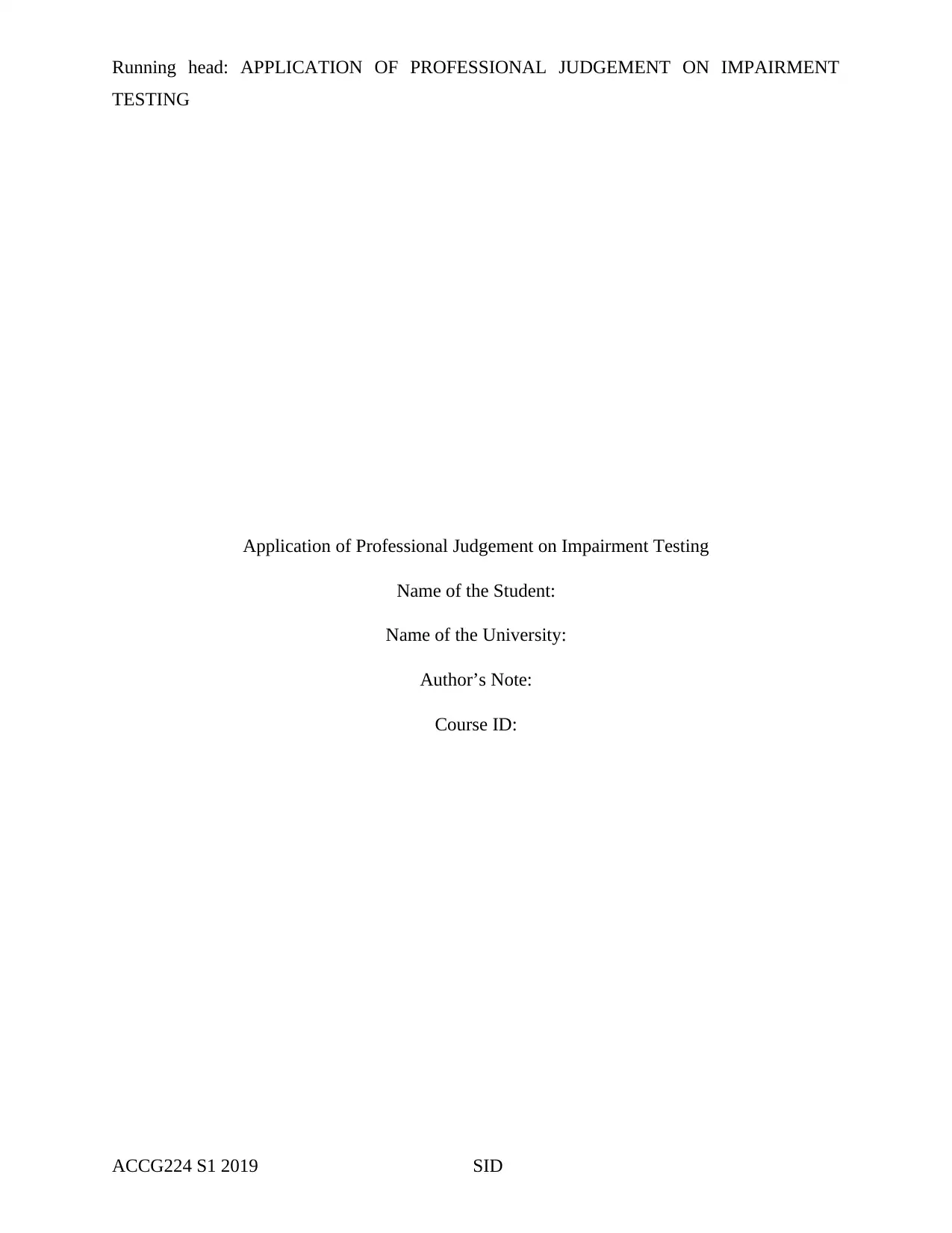
Running head: APPLICATION OF PROFESSIONAL JUDGEMENT ON IMPAIRMENT
TESTING
Application of Professional Judgement on Impairment Testing
Name of the Student:
Name of the University:
Author’s Note:
Course ID:
ACCG224 S1 2019 SID
TESTING
Application of Professional Judgement on Impairment Testing
Name of the Student:
Name of the University:
Author’s Note:
Course ID:
ACCG224 S1 2019 SID
Paraphrase This Document
Need a fresh take? Get an instant paraphrase of this document with our AI Paraphraser
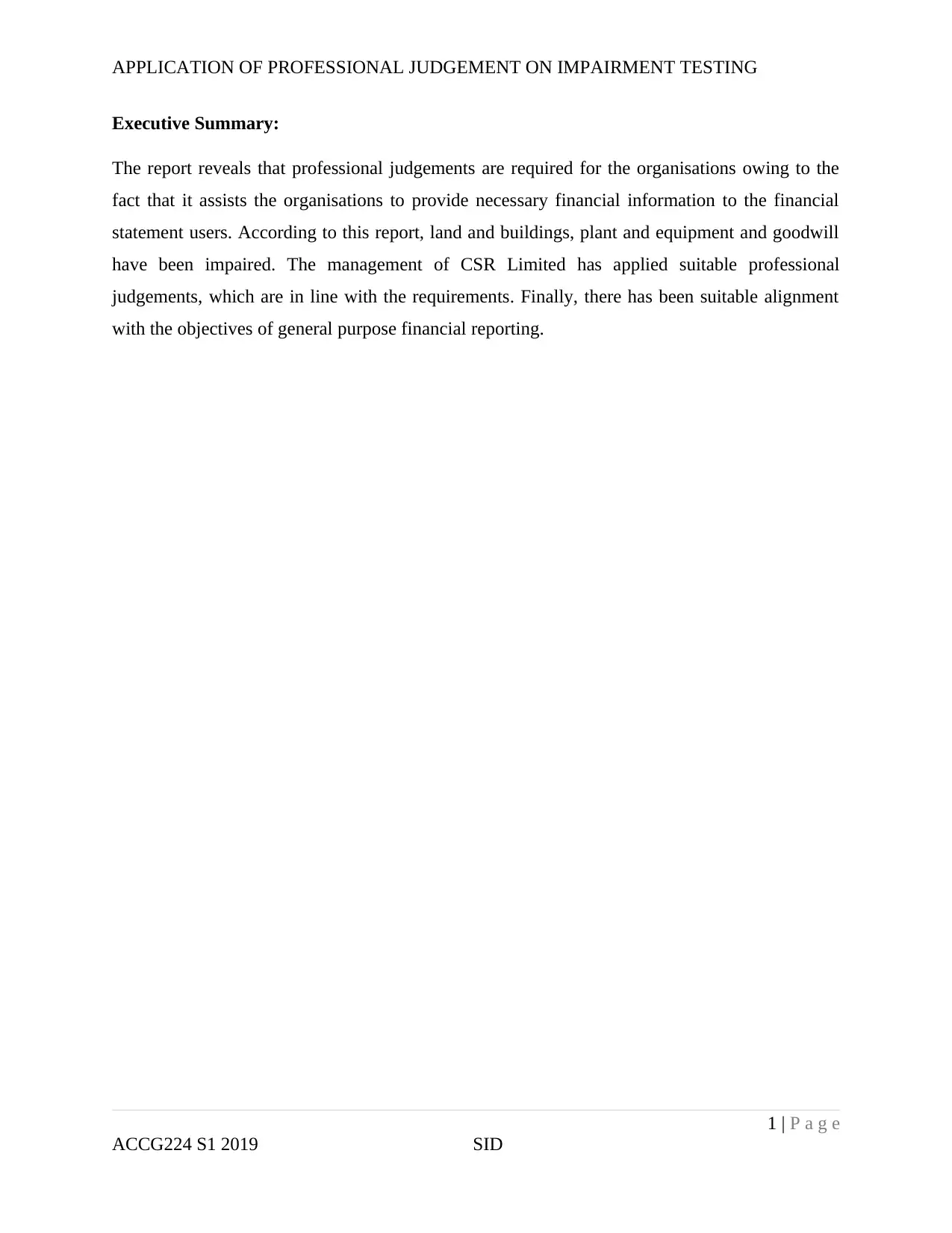
APPLICATION OF PROFESSIONAL JUDGEMENT ON IMPAIRMENT TESTING
Executive Summary:
The report reveals that professional judgements are required for the organisations owing to the
fact that it assists the organisations to provide necessary financial information to the financial
statement users. According to this report, land and buildings, plant and equipment and goodwill
have been impaired. The management of CSR Limited has applied suitable professional
judgements, which are in line with the requirements. Finally, there has been suitable alignment
with the objectives of general purpose financial reporting.
1 | P a g e
ACCG224 S1 2019 SID
Executive Summary:
The report reveals that professional judgements are required for the organisations owing to the
fact that it assists the organisations to provide necessary financial information to the financial
statement users. According to this report, land and buildings, plant and equipment and goodwill
have been impaired. The management of CSR Limited has applied suitable professional
judgements, which are in line with the requirements. Finally, there has been suitable alignment
with the objectives of general purpose financial reporting.
1 | P a g e
ACCG224 S1 2019 SID
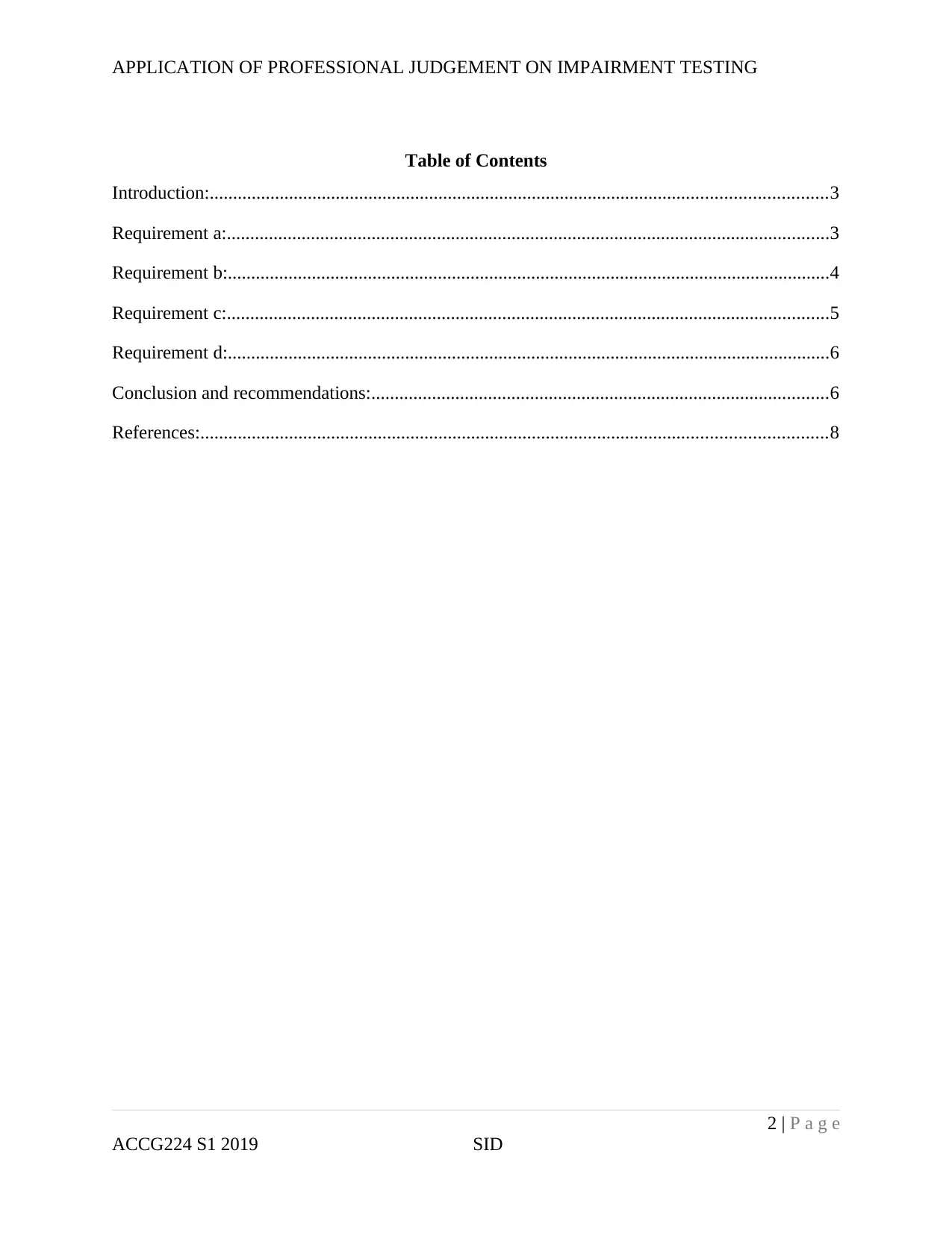
APPLICATION OF PROFESSIONAL JUDGEMENT ON IMPAIRMENT TESTING
Table of Contents
Introduction:....................................................................................................................................3
Requirement a:.................................................................................................................................3
Requirement b:.................................................................................................................................4
Requirement c:.................................................................................................................................5
Requirement d:.................................................................................................................................6
Conclusion and recommendations:..................................................................................................6
References:......................................................................................................................................8
2 | P a g e
ACCG224 S1 2019 SID
Table of Contents
Introduction:....................................................................................................................................3
Requirement a:.................................................................................................................................3
Requirement b:.................................................................................................................................4
Requirement c:.................................................................................................................................5
Requirement d:.................................................................................................................................6
Conclusion and recommendations:..................................................................................................6
References:......................................................................................................................................8
2 | P a g e
ACCG224 S1 2019 SID
⊘ This is a preview!⊘
Do you want full access?
Subscribe today to unlock all pages.

Trusted by 1+ million students worldwide
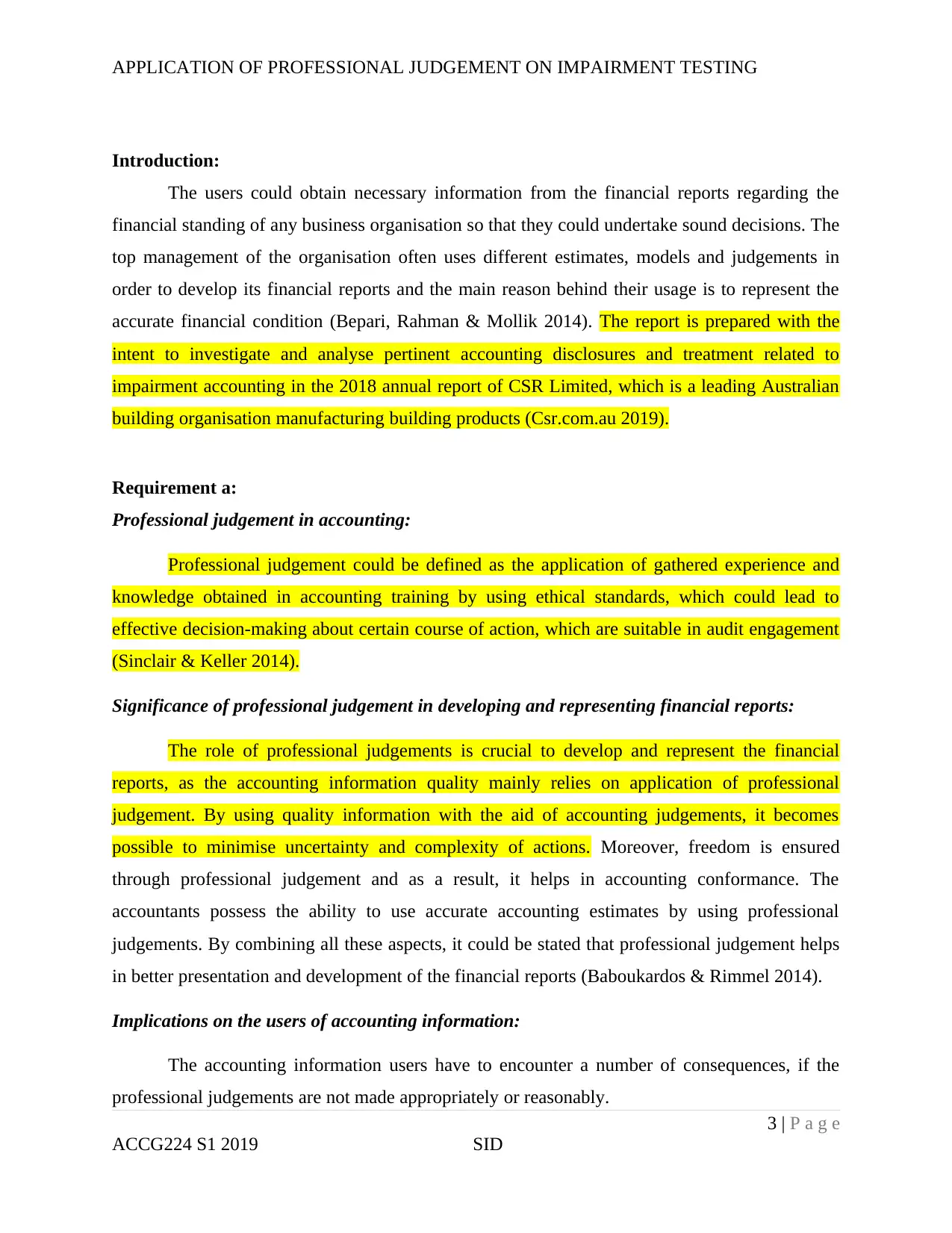
APPLICATION OF PROFESSIONAL JUDGEMENT ON IMPAIRMENT TESTING
Introduction:
The users could obtain necessary information from the financial reports regarding the
financial standing of any business organisation so that they could undertake sound decisions. The
top management of the organisation often uses different estimates, models and judgements in
order to develop its financial reports and the main reason behind their usage is to represent the
accurate financial condition (Bepari, Rahman & Mollik 2014). The report is prepared with the
intent to investigate and analyse pertinent accounting disclosures and treatment related to
impairment accounting in the 2018 annual report of CSR Limited, which is a leading Australian
building organisation manufacturing building products (Csr.com.au 2019).
Requirement a:
Professional judgement in accounting:
Professional judgement could be defined as the application of gathered experience and
knowledge obtained in accounting training by using ethical standards, which could lead to
effective decision-making about certain course of action, which are suitable in audit engagement
(Sinclair & Keller 2014).
Significance of professional judgement in developing and representing financial reports:
The role of professional judgements is crucial to develop and represent the financial
reports, as the accounting information quality mainly relies on application of professional
judgement. By using quality information with the aid of accounting judgements, it becomes
possible to minimise uncertainty and complexity of actions. Moreover, freedom is ensured
through professional judgement and as a result, it helps in accounting conformance. The
accountants possess the ability to use accurate accounting estimates by using professional
judgements. By combining all these aspects, it could be stated that professional judgement helps
in better presentation and development of the financial reports (Baboukardos & Rimmel 2014).
Implications on the users of accounting information:
The accounting information users have to encounter a number of consequences, if the
professional judgements are not made appropriately or reasonably.
3 | P a g e
ACCG224 S1 2019 SID
Introduction:
The users could obtain necessary information from the financial reports regarding the
financial standing of any business organisation so that they could undertake sound decisions. The
top management of the organisation often uses different estimates, models and judgements in
order to develop its financial reports and the main reason behind their usage is to represent the
accurate financial condition (Bepari, Rahman & Mollik 2014). The report is prepared with the
intent to investigate and analyse pertinent accounting disclosures and treatment related to
impairment accounting in the 2018 annual report of CSR Limited, which is a leading Australian
building organisation manufacturing building products (Csr.com.au 2019).
Requirement a:
Professional judgement in accounting:
Professional judgement could be defined as the application of gathered experience and
knowledge obtained in accounting training by using ethical standards, which could lead to
effective decision-making about certain course of action, which are suitable in audit engagement
(Sinclair & Keller 2014).
Significance of professional judgement in developing and representing financial reports:
The role of professional judgements is crucial to develop and represent the financial
reports, as the accounting information quality mainly relies on application of professional
judgement. By using quality information with the aid of accounting judgements, it becomes
possible to minimise uncertainty and complexity of actions. Moreover, freedom is ensured
through professional judgement and as a result, it helps in accounting conformance. The
accountants possess the ability to use accurate accounting estimates by using professional
judgements. By combining all these aspects, it could be stated that professional judgement helps
in better presentation and development of the financial reports (Baboukardos & Rimmel 2014).
Implications on the users of accounting information:
The accounting information users have to encounter a number of consequences, if the
professional judgements are not made appropriately or reasonably.
3 | P a g e
ACCG224 S1 2019 SID
Paraphrase This Document
Need a fresh take? Get an instant paraphrase of this document with our AI Paraphraser
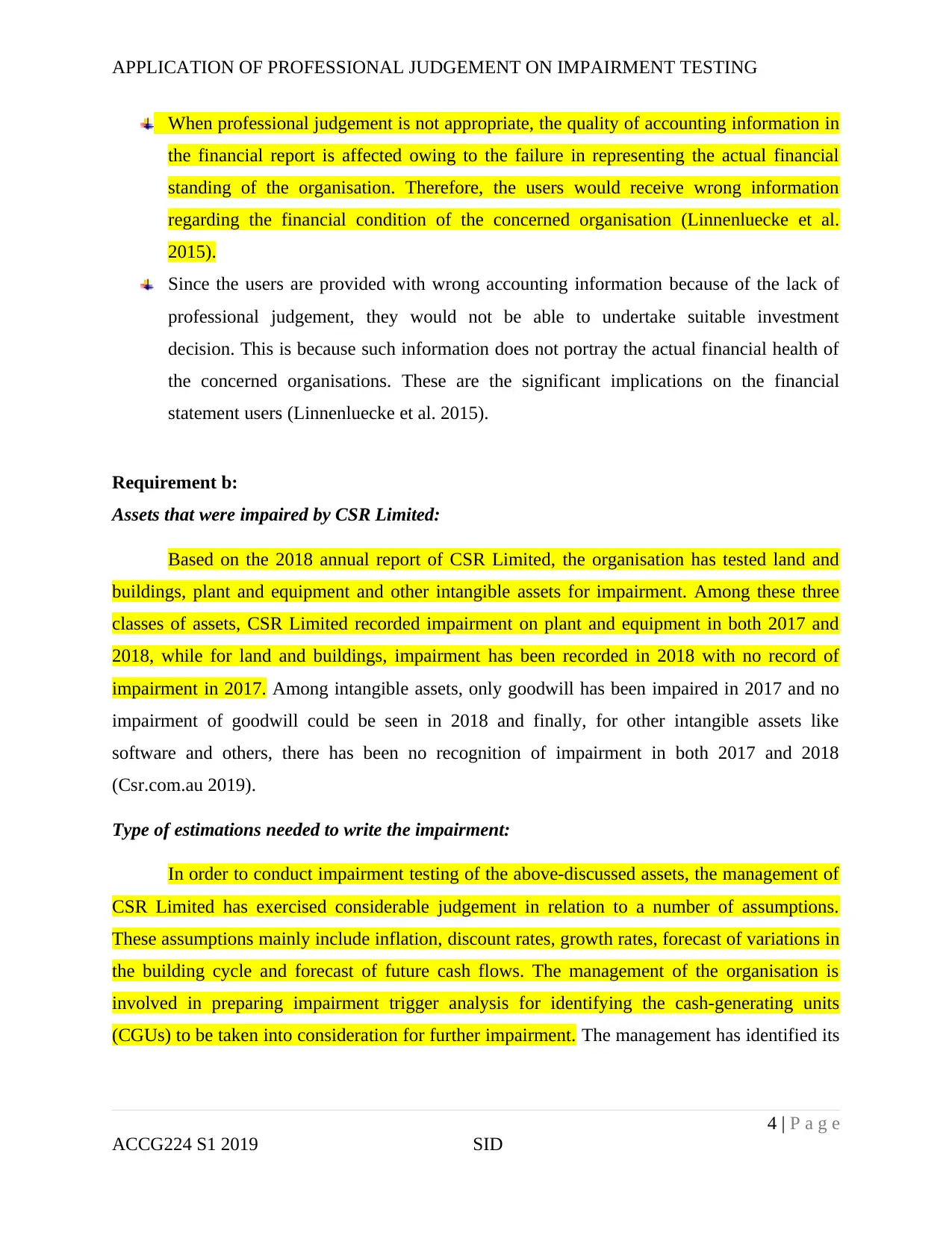
APPLICATION OF PROFESSIONAL JUDGEMENT ON IMPAIRMENT TESTING
When professional judgement is not appropriate, the quality of accounting information in
the financial report is affected owing to the failure in representing the actual financial
standing of the organisation. Therefore, the users would receive wrong information
regarding the financial condition of the concerned organisation (Linnenluecke et al.
2015).
Since the users are provided with wrong accounting information because of the lack of
professional judgement, they would not be able to undertake suitable investment
decision. This is because such information does not portray the actual financial health of
the concerned organisations. These are the significant implications on the financial
statement users (Linnenluecke et al. 2015).
Requirement b:
Assets that were impaired by CSR Limited:
Based on the 2018 annual report of CSR Limited, the organisation has tested land and
buildings, plant and equipment and other intangible assets for impairment. Among these three
classes of assets, CSR Limited recorded impairment on plant and equipment in both 2017 and
2018, while for land and buildings, impairment has been recorded in 2018 with no record of
impairment in 2017. Among intangible assets, only goodwill has been impaired in 2017 and no
impairment of goodwill could be seen in 2018 and finally, for other intangible assets like
software and others, there has been no recognition of impairment in both 2017 and 2018
(Csr.com.au 2019).
Type of estimations needed to write the impairment:
In order to conduct impairment testing of the above-discussed assets, the management of
CSR Limited has exercised considerable judgement in relation to a number of assumptions.
These assumptions mainly include inflation, discount rates, growth rates, forecast of variations in
the building cycle and forecast of future cash flows. The management of the organisation is
involved in preparing impairment trigger analysis for identifying the cash-generating units
(CGUs) to be taken into consideration for further impairment. The management has identified its
4 | P a g e
ACCG224 S1 2019 SID
When professional judgement is not appropriate, the quality of accounting information in
the financial report is affected owing to the failure in representing the actual financial
standing of the organisation. Therefore, the users would receive wrong information
regarding the financial condition of the concerned organisation (Linnenluecke et al.
2015).
Since the users are provided with wrong accounting information because of the lack of
professional judgement, they would not be able to undertake suitable investment
decision. This is because such information does not portray the actual financial health of
the concerned organisations. These are the significant implications on the financial
statement users (Linnenluecke et al. 2015).
Requirement b:
Assets that were impaired by CSR Limited:
Based on the 2018 annual report of CSR Limited, the organisation has tested land and
buildings, plant and equipment and other intangible assets for impairment. Among these three
classes of assets, CSR Limited recorded impairment on plant and equipment in both 2017 and
2018, while for land and buildings, impairment has been recorded in 2018 with no record of
impairment in 2017. Among intangible assets, only goodwill has been impaired in 2017 and no
impairment of goodwill could be seen in 2018 and finally, for other intangible assets like
software and others, there has been no recognition of impairment in both 2017 and 2018
(Csr.com.au 2019).
Type of estimations needed to write the impairment:
In order to conduct impairment testing of the above-discussed assets, the management of
CSR Limited has exercised considerable judgement in relation to a number of assumptions.
These assumptions mainly include inflation, discount rates, growth rates, forecast of variations in
the building cycle and forecast of future cash flows. The management of the organisation is
involved in preparing impairment trigger analysis for identifying the cash-generating units
(CGUs) to be taken into consideration for further impairment. The management has identified its
4 | P a g e
ACCG224 S1 2019 SID
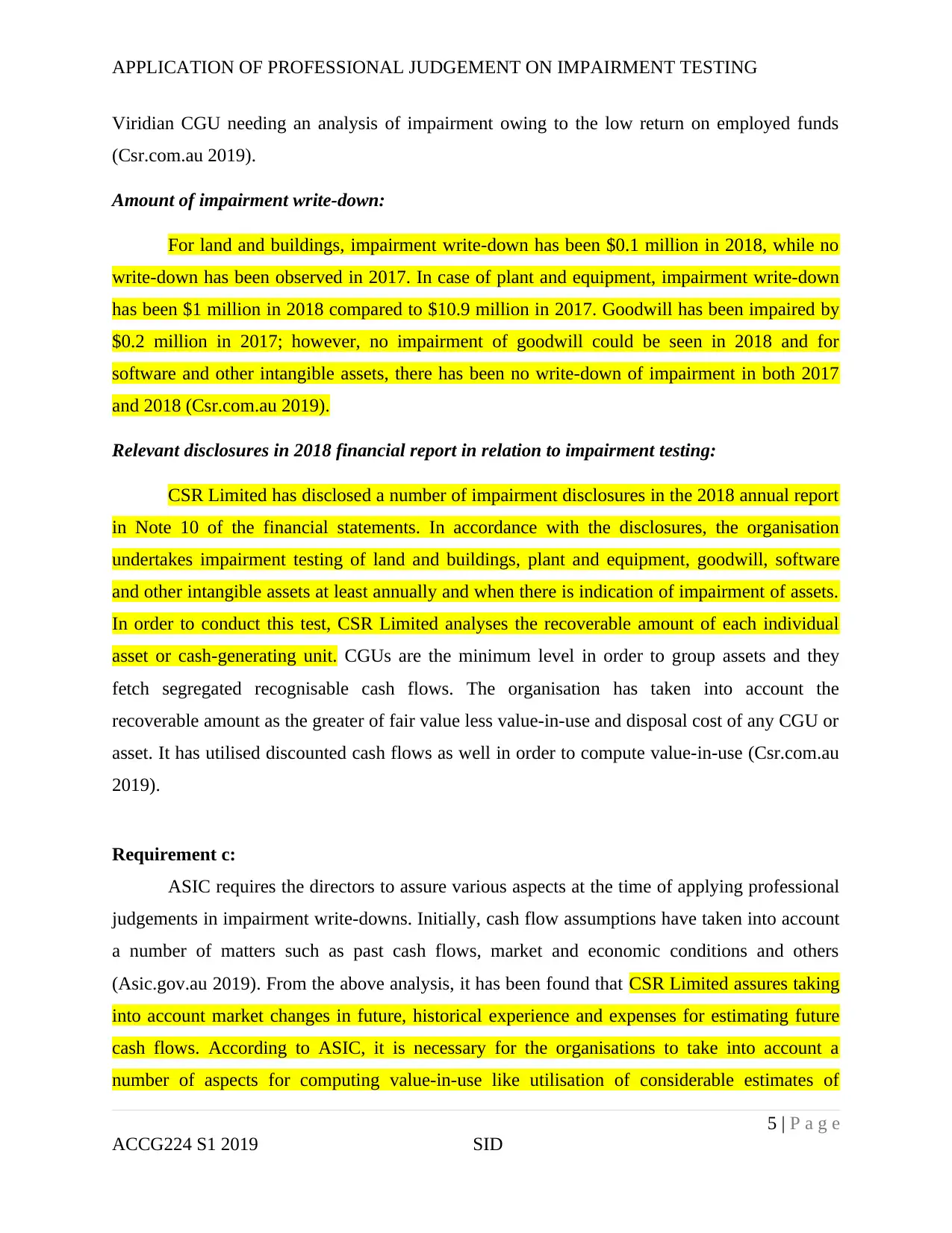
APPLICATION OF PROFESSIONAL JUDGEMENT ON IMPAIRMENT TESTING
Viridian CGU needing an analysis of impairment owing to the low return on employed funds
(Csr.com.au 2019).
Amount of impairment write-down:
For land and buildings, impairment write-down has been $0.1 million in 2018, while no
write-down has been observed in 2017. In case of plant and equipment, impairment write-down
has been $1 million in 2018 compared to $10.9 million in 2017. Goodwill has been impaired by
$0.2 million in 2017; however, no impairment of goodwill could be seen in 2018 and for
software and other intangible assets, there has been no write-down of impairment in both 2017
and 2018 (Csr.com.au 2019).
Relevant disclosures in 2018 financial report in relation to impairment testing:
CSR Limited has disclosed a number of impairment disclosures in the 2018 annual report
in Note 10 of the financial statements. In accordance with the disclosures, the organisation
undertakes impairment testing of land and buildings, plant and equipment, goodwill, software
and other intangible assets at least annually and when there is indication of impairment of assets.
In order to conduct this test, CSR Limited analyses the recoverable amount of each individual
asset or cash-generating unit. CGUs are the minimum level in order to group assets and they
fetch segregated recognisable cash flows. The organisation has taken into account the
recoverable amount as the greater of fair value less value-in-use and disposal cost of any CGU or
asset. It has utilised discounted cash flows as well in order to compute value-in-use (Csr.com.au
2019).
Requirement c:
ASIC requires the directors to assure various aspects at the time of applying professional
judgements in impairment write-downs. Initially, cash flow assumptions have taken into account
a number of matters such as past cash flows, market and economic conditions and others
(Asic.gov.au 2019). From the above analysis, it has been found that CSR Limited assures taking
into account market changes in future, historical experience and expenses for estimating future
cash flows. According to ASIC, it is necessary for the organisations to take into account a
number of aspects for computing value-in-use like utilisation of considerable estimates of
5 | P a g e
ACCG224 S1 2019 SID
Viridian CGU needing an analysis of impairment owing to the low return on employed funds
(Csr.com.au 2019).
Amount of impairment write-down:
For land and buildings, impairment write-down has been $0.1 million in 2018, while no
write-down has been observed in 2017. In case of plant and equipment, impairment write-down
has been $1 million in 2018 compared to $10.9 million in 2017. Goodwill has been impaired by
$0.2 million in 2017; however, no impairment of goodwill could be seen in 2018 and for
software and other intangible assets, there has been no write-down of impairment in both 2017
and 2018 (Csr.com.au 2019).
Relevant disclosures in 2018 financial report in relation to impairment testing:
CSR Limited has disclosed a number of impairment disclosures in the 2018 annual report
in Note 10 of the financial statements. In accordance with the disclosures, the organisation
undertakes impairment testing of land and buildings, plant and equipment, goodwill, software
and other intangible assets at least annually and when there is indication of impairment of assets.
In order to conduct this test, CSR Limited analyses the recoverable amount of each individual
asset or cash-generating unit. CGUs are the minimum level in order to group assets and they
fetch segregated recognisable cash flows. The organisation has taken into account the
recoverable amount as the greater of fair value less value-in-use and disposal cost of any CGU or
asset. It has utilised discounted cash flows as well in order to compute value-in-use (Csr.com.au
2019).
Requirement c:
ASIC requires the directors to assure various aspects at the time of applying professional
judgements in impairment write-downs. Initially, cash flow assumptions have taken into account
a number of matters such as past cash flows, market and economic conditions and others
(Asic.gov.au 2019). From the above analysis, it has been found that CSR Limited assures taking
into account market changes in future, historical experience and expenses for estimating future
cash flows. According to ASIC, it is necessary for the organisations to take into account a
number of aspects for computing value-in-use like utilisation of considerable estimates of
5 | P a g e
ACCG224 S1 2019 SID
⊘ This is a preview!⊘
Do you want full access?
Subscribe today to unlock all pages.

Trusted by 1+ million students worldwide
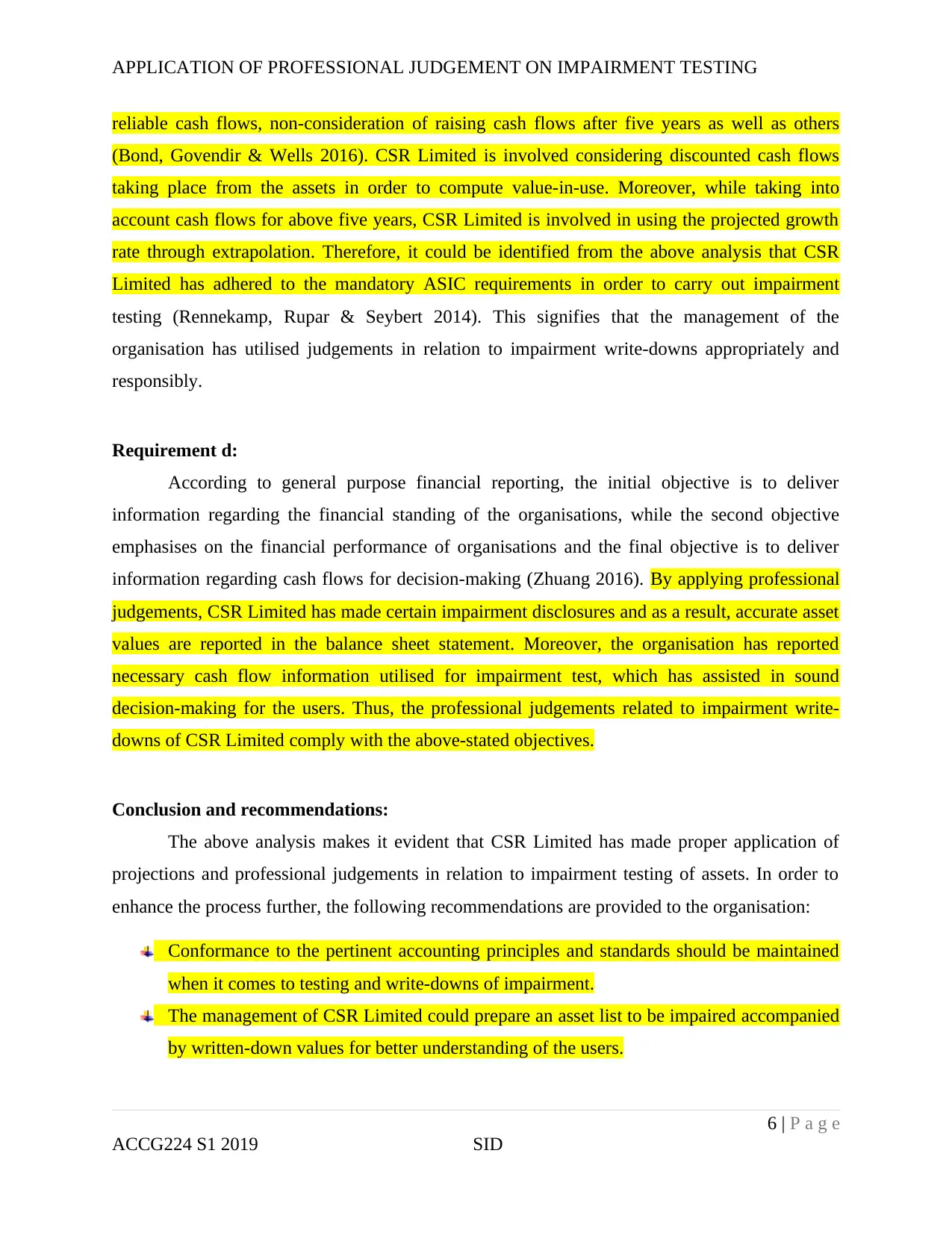
APPLICATION OF PROFESSIONAL JUDGEMENT ON IMPAIRMENT TESTING
reliable cash flows, non-consideration of raising cash flows after five years as well as others
(Bond, Govendir & Wells 2016). CSR Limited is involved considering discounted cash flows
taking place from the assets in order to compute value-in-use. Moreover, while taking into
account cash flows for above five years, CSR Limited is involved in using the projected growth
rate through extrapolation. Therefore, it could be identified from the above analysis that CSR
Limited has adhered to the mandatory ASIC requirements in order to carry out impairment
testing (Rennekamp, Rupar & Seybert 2014). This signifies that the management of the
organisation has utilised judgements in relation to impairment write-downs appropriately and
responsibly.
Requirement d:
According to general purpose financial reporting, the initial objective is to deliver
information regarding the financial standing of the organisations, while the second objective
emphasises on the financial performance of organisations and the final objective is to deliver
information regarding cash flows for decision-making (Zhuang 2016). By applying professional
judgements, CSR Limited has made certain impairment disclosures and as a result, accurate asset
values are reported in the balance sheet statement. Moreover, the organisation has reported
necessary cash flow information utilised for impairment test, which has assisted in sound
decision-making for the users. Thus, the professional judgements related to impairment write-
downs of CSR Limited comply with the above-stated objectives.
Conclusion and recommendations:
The above analysis makes it evident that CSR Limited has made proper application of
projections and professional judgements in relation to impairment testing of assets. In order to
enhance the process further, the following recommendations are provided to the organisation:
Conformance to the pertinent accounting principles and standards should be maintained
when it comes to testing and write-downs of impairment.
The management of CSR Limited could prepare an asset list to be impaired accompanied
by written-down values for better understanding of the users.
6 | P a g e
ACCG224 S1 2019 SID
reliable cash flows, non-consideration of raising cash flows after five years as well as others
(Bond, Govendir & Wells 2016). CSR Limited is involved considering discounted cash flows
taking place from the assets in order to compute value-in-use. Moreover, while taking into
account cash flows for above five years, CSR Limited is involved in using the projected growth
rate through extrapolation. Therefore, it could be identified from the above analysis that CSR
Limited has adhered to the mandatory ASIC requirements in order to carry out impairment
testing (Rennekamp, Rupar & Seybert 2014). This signifies that the management of the
organisation has utilised judgements in relation to impairment write-downs appropriately and
responsibly.
Requirement d:
According to general purpose financial reporting, the initial objective is to deliver
information regarding the financial standing of the organisations, while the second objective
emphasises on the financial performance of organisations and the final objective is to deliver
information regarding cash flows for decision-making (Zhuang 2016). By applying professional
judgements, CSR Limited has made certain impairment disclosures and as a result, accurate asset
values are reported in the balance sheet statement. Moreover, the organisation has reported
necessary cash flow information utilised for impairment test, which has assisted in sound
decision-making for the users. Thus, the professional judgements related to impairment write-
downs of CSR Limited comply with the above-stated objectives.
Conclusion and recommendations:
The above analysis makes it evident that CSR Limited has made proper application of
projections and professional judgements in relation to impairment testing of assets. In order to
enhance the process further, the following recommendations are provided to the organisation:
Conformance to the pertinent accounting principles and standards should be maintained
when it comes to testing and write-downs of impairment.
The management of CSR Limited could prepare an asset list to be impaired accompanied
by written-down values for better understanding of the users.
6 | P a g e
ACCG224 S1 2019 SID
Paraphrase This Document
Need a fresh take? Get an instant paraphrase of this document with our AI Paraphraser
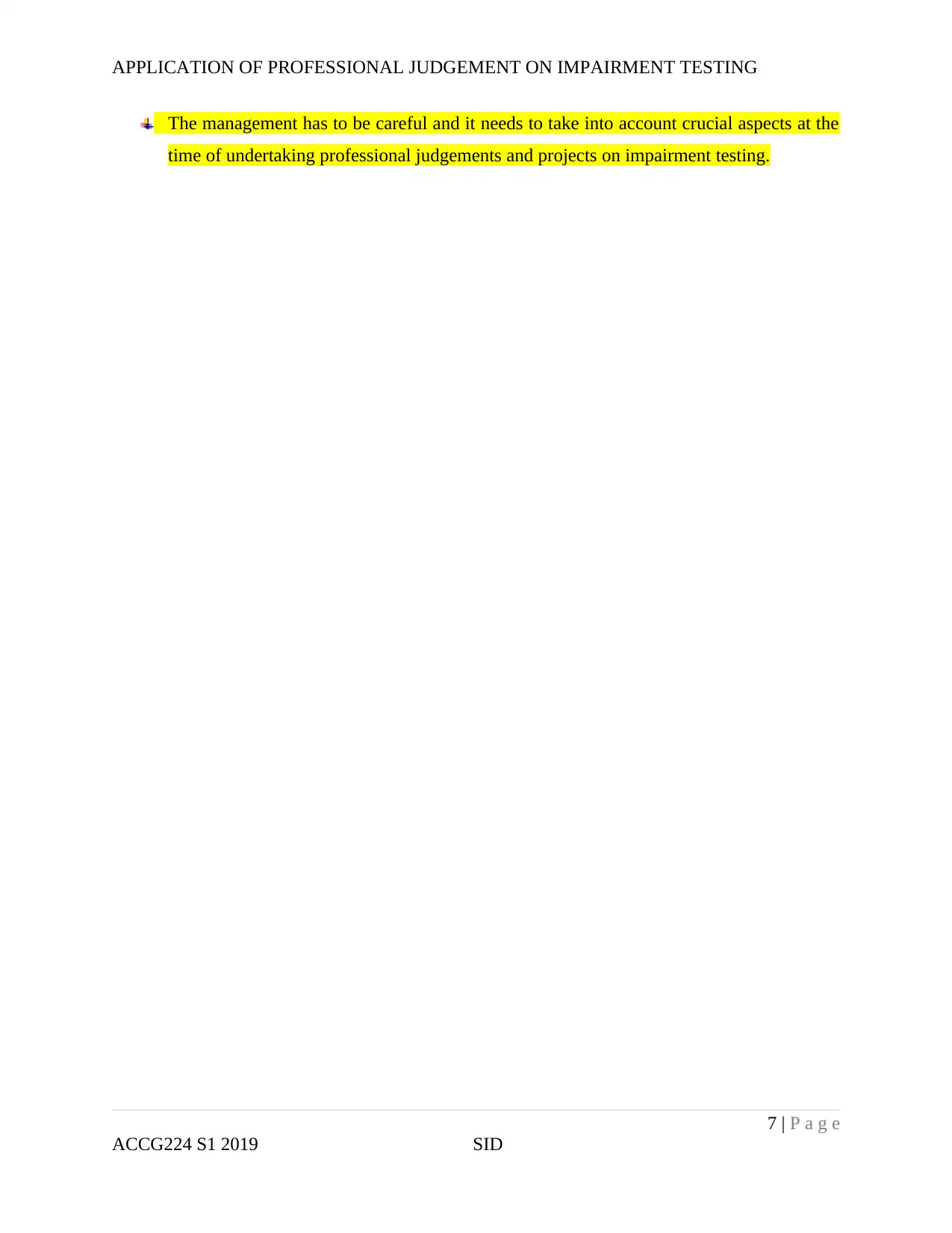
APPLICATION OF PROFESSIONAL JUDGEMENT ON IMPAIRMENT TESTING
The management has to be careful and it needs to take into account crucial aspects at the
time of undertaking professional judgements and projects on impairment testing.
7 | P a g e
ACCG224 S1 2019 SID
The management has to be careful and it needs to take into account crucial aspects at the
time of undertaking professional judgements and projects on impairment testing.
7 | P a g e
ACCG224 S1 2019 SID
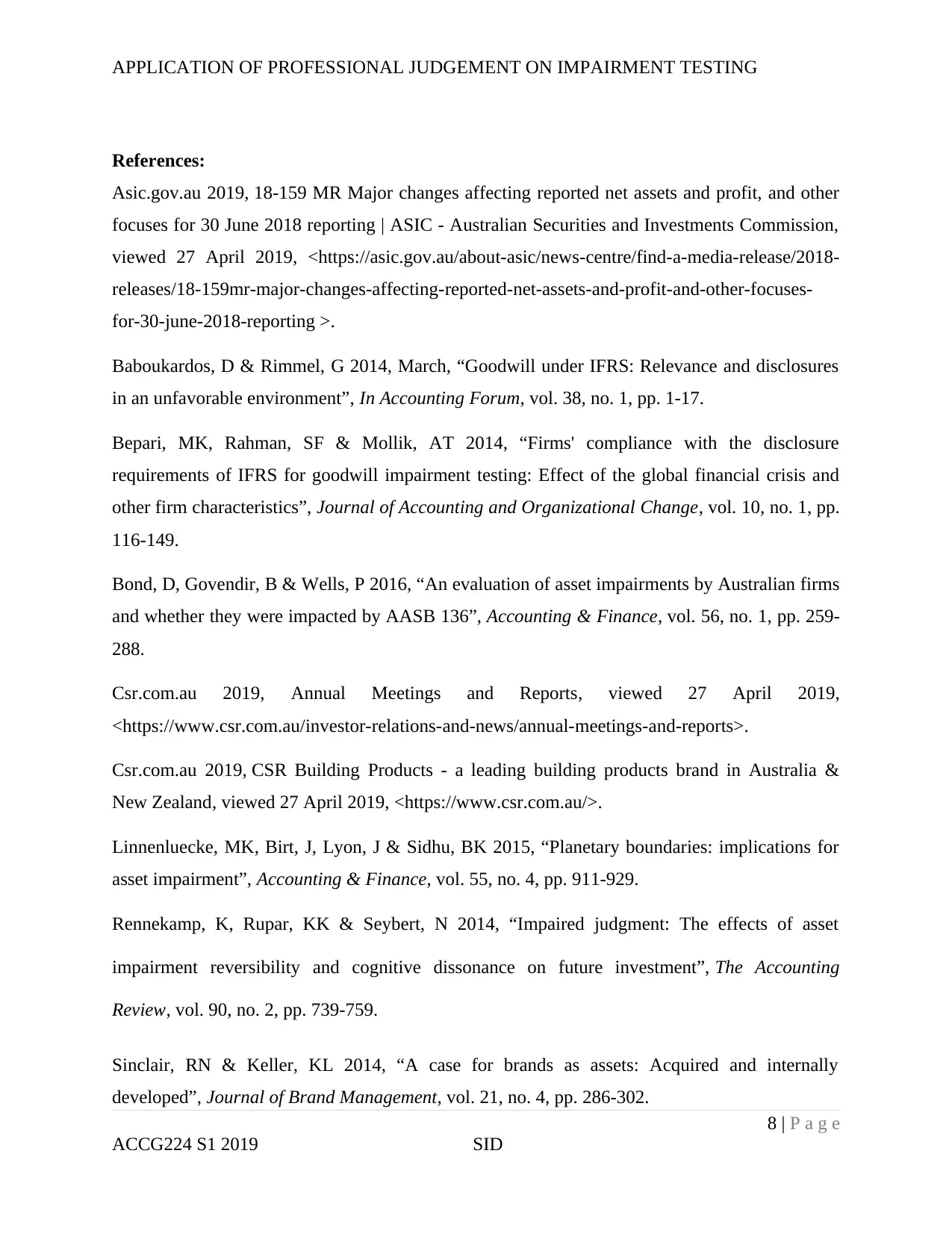
APPLICATION OF PROFESSIONAL JUDGEMENT ON IMPAIRMENT TESTING
References:
Asic.gov.au 2019, 18-159 MR Major changes affecting reported net assets and profit, and other
focuses for 30 June 2018 reporting | ASIC - Australian Securities and Investments Commission,
viewed 27 April 2019, <https://asic.gov.au/about-asic/news-centre/find-a-media-release/2018-
releases/18-159mr-major-changes-affecting-reported-net-assets-and-profit-and-other-focuses-
for-30-june-2018-reporting >.
Baboukardos, D & Rimmel, G 2014, March, “Goodwill under IFRS: Relevance and disclosures
in an unfavorable environment”, In Accounting Forum, vol. 38, no. 1, pp. 1-17.
Bepari, MK, Rahman, SF & Mollik, AT 2014, “Firms' compliance with the disclosure
requirements of IFRS for goodwill impairment testing: Effect of the global financial crisis and
other firm characteristics”, Journal of Accounting and Organizational Change, vol. 10, no. 1, pp.
116-149.
Bond, D, Govendir, B & Wells, P 2016, “An evaluation of asset impairments by Australian firms
and whether they were impacted by AASB 136”, Accounting & Finance, vol. 56, no. 1, pp. 259-
288.
Csr.com.au 2019, Annual Meetings and Reports, viewed 27 April 2019,
<https://www.csr.com.au/investor-relations-and-news/annual-meetings-and-reports>.
Csr.com.au 2019, CSR Building Products - a leading building products brand in Australia &
New Zealand, viewed 27 April 2019, <https://www.csr.com.au/>.
Linnenluecke, MK, Birt, J, Lyon, J & Sidhu, BK 2015, “Planetary boundaries: implications for
asset impairment”, Accounting & Finance, vol. 55, no. 4, pp. 911-929.
Rennekamp, K, Rupar, KK & Seybert, N 2014, “Impaired judgment: The effects of asset
impairment reversibility and cognitive dissonance on future investment”, The Accounting
Review, vol. 90, no. 2, pp. 739-759.
Sinclair, RN & Keller, KL 2014, “A case for brands as assets: Acquired and internally
developed”, Journal of Brand Management, vol. 21, no. 4, pp. 286-302.
8 | P a g e
ACCG224 S1 2019 SID
References:
Asic.gov.au 2019, 18-159 MR Major changes affecting reported net assets and profit, and other
focuses for 30 June 2018 reporting | ASIC - Australian Securities and Investments Commission,
viewed 27 April 2019, <https://asic.gov.au/about-asic/news-centre/find-a-media-release/2018-
releases/18-159mr-major-changes-affecting-reported-net-assets-and-profit-and-other-focuses-
for-30-june-2018-reporting >.
Baboukardos, D & Rimmel, G 2014, March, “Goodwill under IFRS: Relevance and disclosures
in an unfavorable environment”, In Accounting Forum, vol. 38, no. 1, pp. 1-17.
Bepari, MK, Rahman, SF & Mollik, AT 2014, “Firms' compliance with the disclosure
requirements of IFRS for goodwill impairment testing: Effect of the global financial crisis and
other firm characteristics”, Journal of Accounting and Organizational Change, vol. 10, no. 1, pp.
116-149.
Bond, D, Govendir, B & Wells, P 2016, “An evaluation of asset impairments by Australian firms
and whether they were impacted by AASB 136”, Accounting & Finance, vol. 56, no. 1, pp. 259-
288.
Csr.com.au 2019, Annual Meetings and Reports, viewed 27 April 2019,
<https://www.csr.com.au/investor-relations-and-news/annual-meetings-and-reports>.
Csr.com.au 2019, CSR Building Products - a leading building products brand in Australia &
New Zealand, viewed 27 April 2019, <https://www.csr.com.au/>.
Linnenluecke, MK, Birt, J, Lyon, J & Sidhu, BK 2015, “Planetary boundaries: implications for
asset impairment”, Accounting & Finance, vol. 55, no. 4, pp. 911-929.
Rennekamp, K, Rupar, KK & Seybert, N 2014, “Impaired judgment: The effects of asset
impairment reversibility and cognitive dissonance on future investment”, The Accounting
Review, vol. 90, no. 2, pp. 739-759.
Sinclair, RN & Keller, KL 2014, “A case for brands as assets: Acquired and internally
developed”, Journal of Brand Management, vol. 21, no. 4, pp. 286-302.
8 | P a g e
ACCG224 S1 2019 SID
⊘ This is a preview!⊘
Do you want full access?
Subscribe today to unlock all pages.

Trusted by 1+ million students worldwide
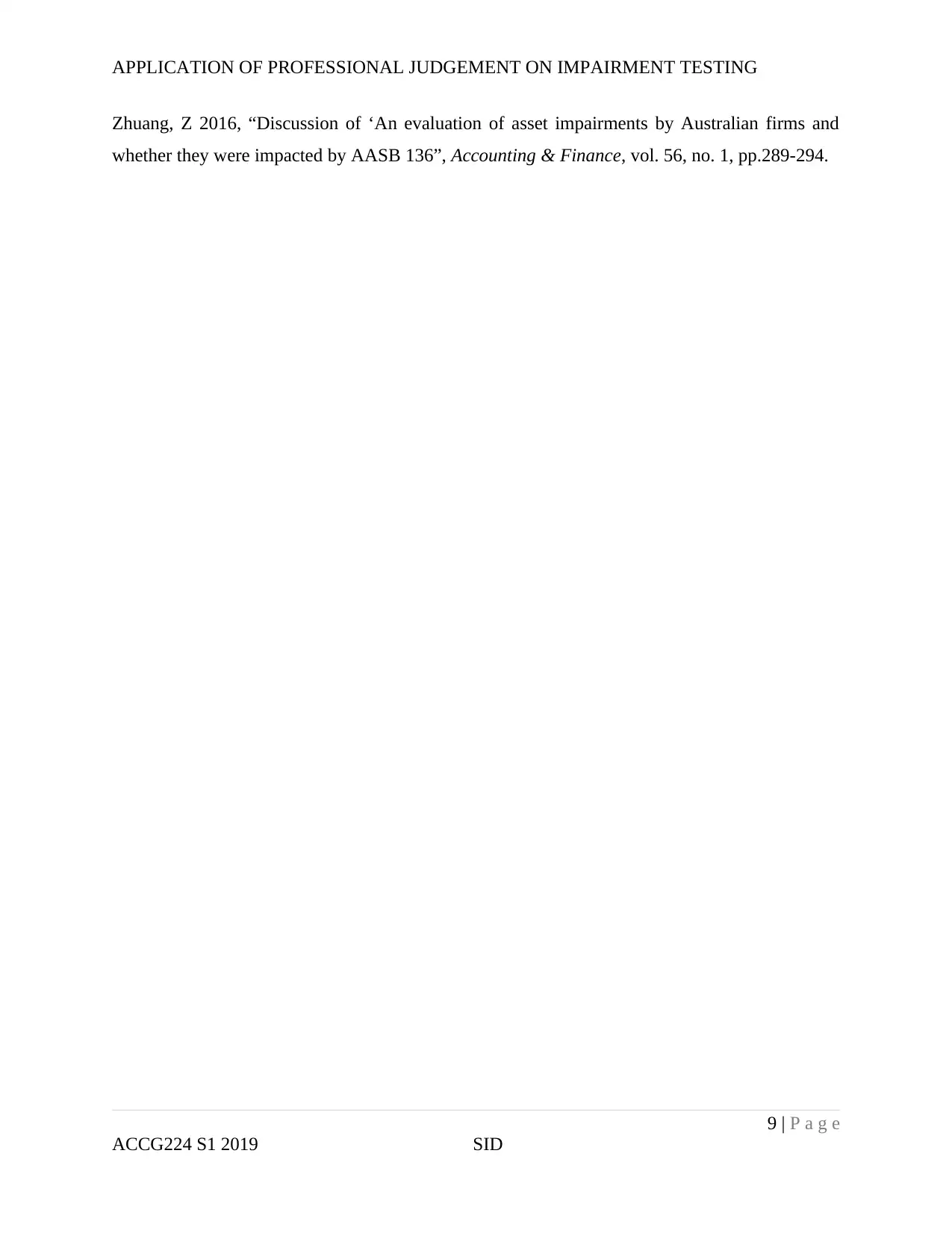
APPLICATION OF PROFESSIONAL JUDGEMENT ON IMPAIRMENT TESTING
Zhuang, Z 2016, “Discussion of ‘An evaluation of asset impairments by Australian firms and
whether they were impacted by AASB 136”, Accounting & Finance, vol. 56, no. 1, pp.289-294.
9 | P a g e
ACCG224 S1 2019 SID
Zhuang, Z 2016, “Discussion of ‘An evaluation of asset impairments by Australian firms and
whether they were impacted by AASB 136”, Accounting & Finance, vol. 56, no. 1, pp.289-294.
9 | P a g e
ACCG224 S1 2019 SID
1 out of 10
Related Documents
Your All-in-One AI-Powered Toolkit for Academic Success.
+13062052269
info@desklib.com
Available 24*7 on WhatsApp / Email
![[object Object]](/_next/static/media/star-bottom.7253800d.svg)
Unlock your academic potential
Copyright © 2020–2025 A2Z Services. All Rights Reserved. Developed and managed by ZUCOL.





